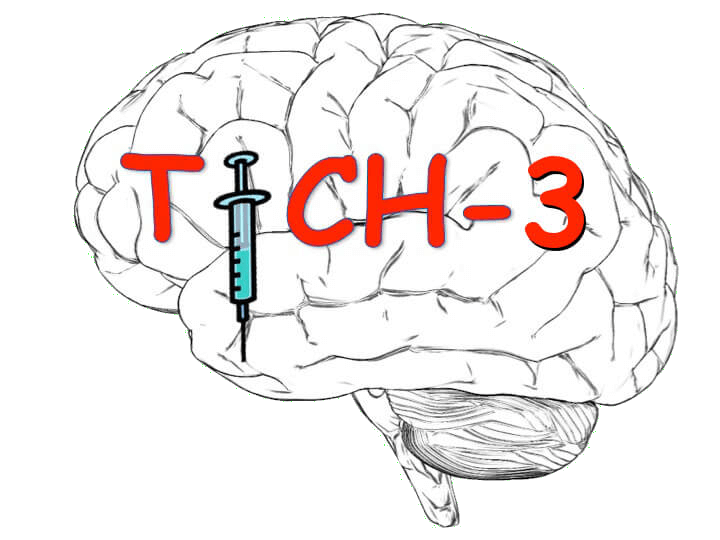
TICH-3 trial
Tranexamic acid for IntraCerebral Haemorrhage 3
| • | Senior trial manager: | |||
| • | Chief investigator: | |||
| • |
Nottingham stroke trials office:
|
|||

|
TICH-3 trialTranexamic acid for IntraCerebral Haemorrhage 3 |
|||||||||||
For further information please contact us.
|
||||||||||||
|
| Title | Tranexamic acid for IntraCerebral Haemorrhage 3 (TICH-3) |
| Acronym | TICH-3 |
| Chief investigator | Professor Nikola Sprigg |
| Objectives |
To assess the clinical effectiveness of TXA after ICH and determine
whether TXA should be used in clinical practice. Primary objective: To assess the effect of TXA on early death (≤ 7 days) Secondary objective: To assess the effect of TXA on dependency 6 months after ICH. |
| Trial configuration | Pragmatic phase III prospective blinded randomised placebo-controlled trial. |
| Setting | Emergency departments, acute stroke services/units across the UK and worldwide. |
| Sample size estimate | 2750 participants per group would allow detection of a difference of 2.57% in the proportion of deaths at day 7 between the placebo and TXA groups (7.74% deaths on TXA, OR of 0.73), at the 5% significance level (2-sided) with 90% power. As the primary outcome is death we anticipate there will be minimal loss to follow up. |
| Number of participants | At least 5,500 |
| Eligibility criteria |
Inclusions
|
| Description of interventions |
|
| Duration of study |
7.25 years project; approximately 5.25 years participant recruitment in
the UK, 4.75 years in international sites. Start date 1 January 2022. Duration of study per participant: 6 months. |
| Randomisation and blinding |
Randomisation will be to TXA vs. placebo in a 1:1 ratio. Due to the emergency situation, a straightforward randomisation process will be used, where sites will simply select the next available treatment pack, which will be a numbered box containing either TXA or placebo according to a computer-defined sequence. Boxes will be identical with the exception of the treatment pack number. Randomisation will be stratified by site with supply to each site balanced for TXA and placebo, using random permuted blocks of varying size. The IMP manufacturer will prepare blinded individual treatment packs containing four 5ml glass ampoules of TXA 500mg or sodium chloride 0.9% which will be identical in appearance. |
| Outcome measures |
Primary outcome: mortality at 7 days. Secondary functional outcome: modified Rankin Scale at (mRS) 180 days. Other secondary outcomes: Death at 2 days. Safety outcomes: Recorded in the first 7 days (or death if sooner): venous thromboembolism; ischaemic events; seizures. Quality of Life (EuroQol [Devlin, Shah, Feng, Mulhern, & van Hout, 2018], EQ-5D-5L, VAS), and cognition (AD-8 [Galvin, Roe, Coats, & Morris, 2007]) at day 180. |
| Statistical methods | The analysis and presentation of the trial results will be in accordance with the CONSORT guidelines. The primary outcome will be compared analysing as randomised without imputation of missing data. Due emphasis will be placed on the confidence intervals for the between arm comparisons. A full Statistical Analysis Plan (SAP) will be developed prior to database lock. The evaluation of the primary outcome will be performed using regression models for binary outcomes, with adjustment for key prognostic factors. The model will be fully specified in the SAP. Absolute and relative measures of effect and 95% confidence intervals will be presented. The primary outcome will also be investigated in prespecified subgroups using appropriate interaction terms. The subgroups will be specified in the SAP and will, at a minimum include age, sex, systolic blood pressure, HV, GCS, the start of treatment (≤2 or >2 hours, ≤3 or >3 hours) and intraventricular haemorrhage (yes, no). |
| Contact details | |
| Address: |
Room S/D2108 Stroke Trials Unit School of Medicine University of Nottingham Queen's Medical Centre Derby Road Nottingham NG7 2UH United Kingdom Tel: +44 (0) 115 823 1782 |
| Email: | |
 UoNStrokeAdara
Switch to mobile site
UoNStrokeAdara
Switch to mobile site